颐和园英文介绍81页PPT
- 格式:ppt
- 大小:6.40 MB
- 文档页数:81
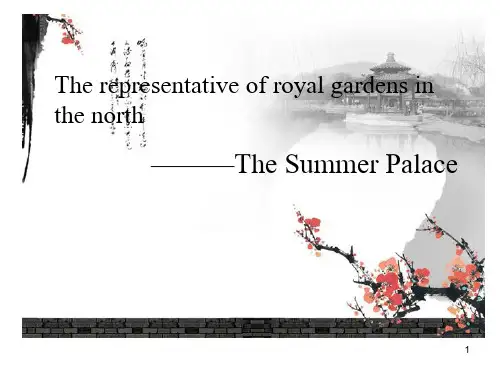
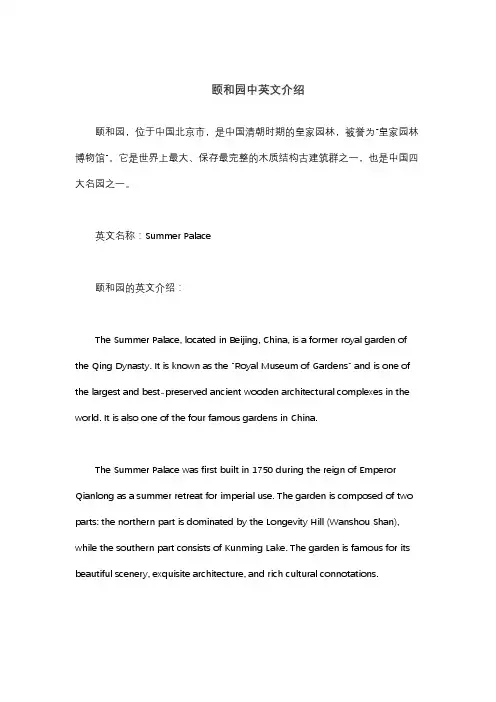
颐和园中英文介绍颐和园,位于中国北京市,是中国清朝时期的皇家园林,被誉为“皇家园林博物馆”。
它是世界上最大、保存最完整的木质结构古建筑群之一,也是中国四大名园之一。
英文名称:Summer Palace颐和园的英文介绍:The Summer Palace, located in Beijing, China, is a former royal garden of the Qing Dynasty. It is known as the "Royal Museum of Gardens" and is one of the largest and best-preserved ancient wooden architectural complexes in the world. It is also one of the four famous gardens in China.The Summer Palace was first built in 1750 during the reign of Emperor Qianlong as a summer retreat for imperial use. The garden is composed of two parts: the northern part is dominated by the Longevity Hill (Wanshou Shan), while the southern part consists of Kunming Lake. The garden is famous for its beautiful scenery, exquisite architecture, and rich cultural connotations.The main attractions in the Summer Palace include the Marble Boat, the Tower of Buddhist Incense, the Hall of Benevolence and Longevity, the Tower of Jade Billows, and the Long Corridor. In addition, the garden is home to many rare and precious cultural relics, such as calligraphy, paintings, bronzes, and ceramics.In 1998, the Summer Palace was designated as a UNESCO World Heritage Site for its outstanding cultural significance and exceptional preservation. Today, it attracts millions of visitors from all over the world every year, making it one of the most popular tourist destinations in China.。


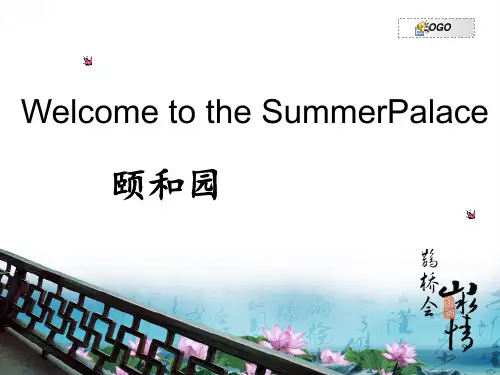
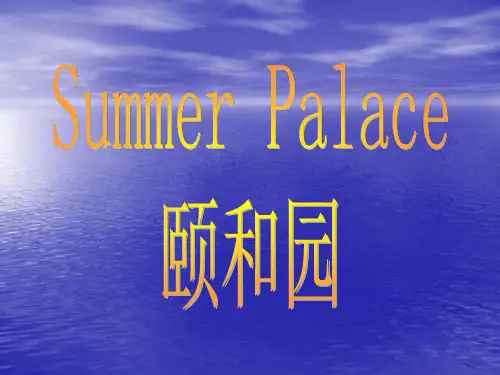
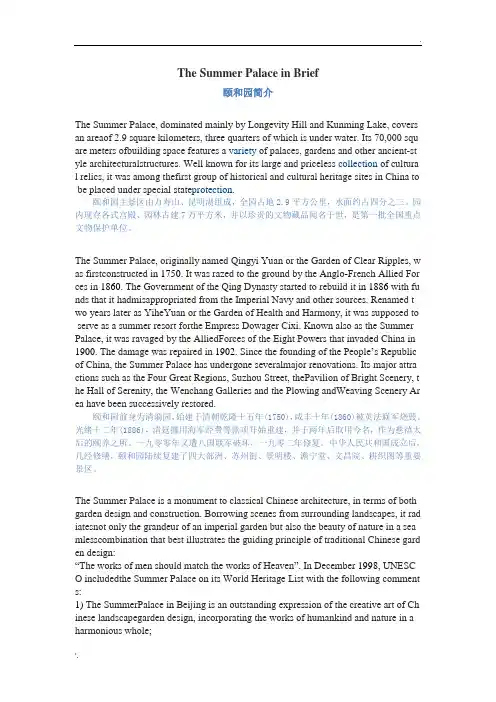
The Summer Palace in Brief颐和园简介The Summer Palace, dominated mainly by Longevity Hill and Kunming Lake, covers an areaof 2.9 square kilometers, three quarters of which is under water. Its 70,000 squ are meters ofbuilding space features a variety of palaces, gardens and other ancient-st yle architecturalstructures. Well known for its large and priceless collection of cultura l relics, it was among thefirst group of historical and cultural heritage sites in China to be placed under special state protection.颐和园主景区由万寿山、昆明湖组成,全园占地2.9平方公里,水面约占四分之三。
园内现存各式宫殿、园林古建7万平方米,并以珍贵的文物藏品闻名于世,是第一批全国重点文物保护单位。
The Summer Palace, originally named Qingyi Yuan or the Garden of Clear Ripples, w as firstconstructed in 1750. It was razed to the ground by the Anglo-French Allied For ces in 1860. The Government of the Qing Dynasty started to rebuild it in 1886 with fu nds that it hadmisappropriated from the Imperial Navy and other sources. Renamed t wo years later as YiheYuan or the Garden of Health and Harmony, it was supposed to serve as a summer resort forthe Empress Dowager Cixi. Known also as the Summer Palace, it was ravaged by the AlliedForces of the Eight Powers that invaded China in 1900. The damage was repaired in 1902. Since the founding of the People’s Republic of China, the Summer Palace has undergone severalmajor renovations. Its major attra ctions such as the Four Great Regions, Suzhou Street, thePavilion of Bright Scenery, t he Hall of Serenity, the Wenchang Galleries and the Plowing andWeaving Scenery Ar ea have been successively restored.颐和园前身为清漪园,始建于清朝乾隆十五年(1750),咸丰十年(1860)被英法联军烧毁。


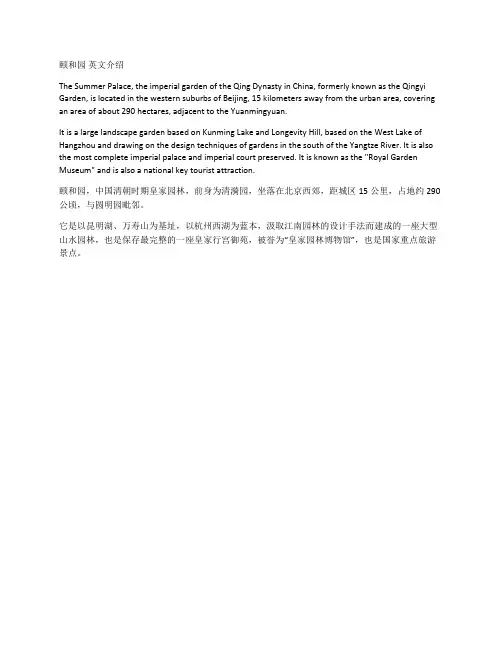
颐和园英文介绍
The Summer Palace, the imperial garden of the Qing Dynasty in China, formerly known as the Qingyi Garden, is located in the western suburbs of Beijing, 15 kilometers away from the urban area, covering an area of about 290 hectares, adjacent to the Yuanmingyuan.
It is a large landscape garden based on Kunming Lake and Longevity Hill, based on the West Lake of Hangzhou and drawing on the design techniques of gardens in the south of the Yangtze River. It is also the most complete imperial palace and imperial court preserved. It is known as the "Royal Garden Museum" and is also a national key tourist attraction.
颐和园,中国清朝时期皇家园林,前身为清漪园,坐落在北京西郊,距城区15公里,占地约290公顷,与圆明园毗邻。
它是以昆明湖、万寿山为基址,以杭州西湖为蓝本,汲取江南园林的设计手法而建成的一座大型山水园林,也是保存最完整的一座皇家行宫御苑,被誉为“皇家园林博物馆”,也是国家重点旅游景点。

Summer Palace, located in the northwest Beijing Haidian District, 15 km from the Beijing City. Covering an area of about 290 hectares, the existing Summer Palace is China's largest, most complete preservation of the imperial garden, t h e S u m m e r P a l a c e,t h e p a l a c e w a s o r i g i n a l l y Q i n g D y n a s t y e m p e r o r s a n d G a r d e n颐和园位于北京西北郊海淀区,距北京城区15千米。
占地约290公顷,颐和园是我国现存规模最大,保存最完整的皇家园林,颐和园原是清朝帝王的行宫和花园.Situated in the western outskirts of Haidian District, the Summer Palace is 15 kilometers (9.3 miles) from central Beijing. Having the largest royal park and being well preserved, it was designated, in 1960 by the State Council, as a Key Cultural Relics Protection Site of China. Containing examples of the ancient arts, it also has graceful landscapes and magnificent constructions. The Summer Palace is the archetypal Chinese garden, and is ranked amongst the most noted and classical gardens of the world. In 1998, it was listed as one of the World Heritage Sites by UNESCO.Constructed in the Jin Dynasty (1115-1234), during the succeeding reign of feudal emperors; it was extended continuously. By the time of the Qing Dynasty (1644-1911), it had become a luxurious royal garden providing royal families with rest and entertainment. Originally called "Qingyi Garden" (Garden of Clear Ripples), it was know as one of the famous "three hills and five gardens" (Longevity Hill, Jade Spring Mountain, and Fragrant Hill; Garden of Clear Ripples, Garden of Everlasting Spring, Garden of Perfection and Brightness, Garden of Tranquility and Brightness, and Garden of Tranquility and Pleasure). Like most of the gardens of Beijing, it could not elude the rampages of the Anglo-French allied force and was destroyed by fire. In 1888, Empress Dowager Cixi embezzled navy funds to reconstruct it for her own benefit, changing its name to Summer Palace (Yiheyuan). She spent most of her later years there, dealing with state affairs and entertaining. In 1900, it suffered again, being ransacked by the Eight-Power Allied Force. After the success of the 1911 Revolution, it was opened to the public.Composed mainly of Longevity Hill and Kunming Lake, The Summer Palace occupies an area of 294 hectares (726.5 acres), three quarters of which is water. Guided by nature, artists designed the gardens exquisitely so that visitors would see marvelous views and be amazed by perfect examples of refined craftwork using the finest materials.Centered on the Tower of Buddhist Incense (Foxiangge) the Summer Palace consists of over 3,000 structures including pavilions, towers, bridges, and corridors. The Summer Palace can be divided into four parts: the court area, front-hill area, front-lake area, and rear-hill and back-lake area.Front-Hill Area: this area is the most magnificent area in the Summer Palace with the most constructions. Its layout is quite distinctive because of the central axis from the yard of Kunming Lake to the hilltop, on which important buildings are positioned including Gate of Dispelling Clouds, Hall of Dispelling Clouds, Hall of Moral Glory, Tower of Buddhist Incense, the Hall of the Sea of Wisdom, etc.Rear-Hill and Back-Lake Area: although the constructions are fewer here, it has a unique landscape, with dense green trees, and winding paths. Visitors can feel a rare tranquility, and elegance. This area includes scenic spots such as Garden of Harmonious Interest and Suzhou Market Street.Court Area: this is where Empress Dowager Cixi and Emperor Guangxu met officials, conducted state affairs and rested. Entering the East Palace Gate, visitors may see the main palace buildings: the Hall of Benevolence and Longevity served as the office of the Emperor, the Hall of Jade Ripples where Guangxu lived, the Hall of Joyful Longevity, Cixi‘s residence, the Hall of Virtue and Harmony where Cixi was entertained.Front Lake Area: covering a larger part of the Summer Palace, opens up the vista of the lake. A breeze fluttering, waves gleam and willows kiss the ripples of the vast water. In this comfortable area there are the Eastern and Western Banks, the Seventeen-Arch Bridge, Nanhu Island, and so on. On the western bank float six distinct bridges amongst which the Jade-Belt Bridge is the most beautiful.颐和园颐和园是我国现存最完好、规模最宏大的古代园林。
Situated in the western outskirts of Haidian District, the Summer Palace is 15 kilometers (9.3 miles) from central Beijing. Having the largest royal park and being well preserved, it was designated, in 1960 by the State Council, as a Key Cultural Relics Protection Site of China. Containing examples of the ancient arts, it also has graceful landscapes and magnificent constructions. The Summer Palace is the archetypal Chinese garden, and is ranked amongst the most noted and classical gardens of the world. In 1998, it was listed as one of the World Heritage Sites by UNESCO. Constructed in the Jin Dynasty (1115-1234), during the succeeding reign of feudal emperors; it was extended continuously. By the time of the Qing Dynasty (1644-1911), it had become a luxurious royal garden providing royal families with rest and entertainment. Originally called "Qingyi Garden" (Garden of Clear Ripples), it was know as one of the famous "three hills and five gardens" (Longevity Hill, Jade Spring Mountain, and Fragrant Hill; Garden of Clear Ripples, Garden of Everlasting Spring, Garden of Perfection and Brightness, Garden of Tranquility and Brightness, and Garden of Tranquility and Pleasure). Like most of the gardens of Beijing, it could not elude the rampages of the Anglo-French allied force and was destroyed by fire. In 1888, Empress Dowager Cixi embezzled navy funds to reconstruct it for her own benefit, changing its name to Summer Palace (Yiheyuan). She spent most of her later years there, dealing with state affairs and entertaining. In 1900, it suffered again, being ransacked by the Eight-Power Allied Force. After the success of the 1911 Revolution, it was opened to the public. Composed mainly of Longevity Hill and Kunming Lake, The Summer Palace occupies an area of 294 hectares (726.5 acres), three quarters of which is water. Guided by nature, artists designed the gardens exquisitely so that visitors would see marvelous views and be amazed by perfect examples of refined craftwork using the finest materials. Centered on the Tower of Buddhist Incense (Foxiangge) the Summer Palace consists of over 3,000 structures including pavilions, towers, bridges, and corridors. The Summer Palace can be divided into four parts: the court area, front-hill area, front-lake area, and rear-hill and back-lake area. Front-Hill Area: this area is the most magnificent area in the Summer Palace with the most constructions. Its layout is quite distinctive because of the central axis from the yard of Kunming Lake to the hilltop, on which important buildings are positioned including Gate of Dispelling Clouds, Hall of Dispelling Clouds, Hall of Moral Glory, Tower of Buddhist Incense, the Hall of the Sea of Wisdom, etc. Rear-Hill and Back-Lake Area: although the constructions are fewer here, it has a unique landscape, with dense green trees, and winding paths. Visitors can feel a rare tranquility, and elegance. This area includes scenic spots such as Garden of Harmonious Interest and Suzhou Market Street. Court Area: this is where Empress Dowager Cixi and Emperor Guangxu met officials, conducted state affairs and rested. Entering the East Palace Gate, visitors may see the main palace buildings: the Hall of Benevolence and Longevity served as the office of the Emperor, the Hall of Jade Ripples where Guangxu lived, the Hall of Joyful Longevity, Cixi‘s residence, the Hall of Virtue and Harmony where Cixi was entertained. Front Lake Area: covering a larger part of the Summer Palace, opens up the vista of the lake. A breeze fluttering, waves gleam and willows kiss the ripples of the vast water. In this comfortable area there are the Eastern and Western Banks, the Seventeen-Arch Bridge, Nanhu Island, and so on. On the western bank float six distinct bridges amongst which the Jade-Belt Bridge is the most beautiful. 颐和园 颐和园是我国现存最完好、规模最宏⼤的古代园林。
颐和园The Summer Palace (Yiheyuan) is a palace in Beijing, China.The initial construction of the Summer Palace began in 1750. Artisans reproduced the garden architecture styles of various palaces in China.It was ransacked, together with the Old Summer Palace in 1860 by French and British troops during the second Opium War. In 1888, Empress Dowager Cixi diverted 30 million taels of silver, said to be originally designated for the Chinese navy, into the reconstruction and enlargement of the Summer Palace.The Summer Palace has been listed by the UNESCO as one of the World Heritage Sites.颐和园的英文介绍Situated in western outskirts of Beijing, the Summer Palace is 10 kilometers from the central city. It is China's leading classical garden which enjoys a worldwide reputation. The Summer Palace was opened to the public in 1924 and included in the UNESCO world heritage list in 1998. A whole day is needed to view it in detail.The Summer Palace was first built in 1153 and served as an imperial palace for short stays away from the capital. Empress Dowager Ci Xi rebuilt it in 1888 with a large sum of money which had been appropriated to build a Chinese navy.The two main elements of the garden are Longevity Hill and Kunming Lake.(万寿山和昆明湖)Kunming Lake, with an exquisite building in the middle, takes up three quarters of the garden's 290 hectares. The garden consists of three parts: the political activity area, the empress's living quarter and the scenic area which separately centers on the Hall of Benevolence and Longevity(1), the Hall of Jade Ripples(2) and the Hall of Happiness and Longevity(3), and Longevity Hill(4) and Kunming Lake. The groups of buildings, hills and lakes, together with the background of West Hills, give an ever changing scene.The buildings on the southern slope of Longevity Hill are characteristic of the garden. Cloud-Dispelling Hall, the Pavilion of the Buddhist Incense(5) and the Wisdom Sea(6) on the axis line are flanked by the Wheel Hall, Wufang Pavilion and Baoyun Pavilion and are major attractions. The Pavilion of the Buddhist Incense is 41 meters high and stands on a 20-meter-high terrace. At the foot of Longevity Hill is the 728-meter-long passageway which links the three areas together. The passageway is famous for its paintings and at its western end is a 36-meter-long Marble Boat(7).The bridges of the western causeway of Kunming Lake are replicas of the bridges of famous Su and Bai causeways on West Lake in Hangzhou. The marble Seventeen-Arch Bridge which spans the Eastern Causeway to South Lake Island has balusters topped by 540 carved lions in different poses.Back Lake at the northern foot of Longevity Hill is natural and peaceful. On its bank is Suzhou Street, a replica of a commercial street in the old days. At the northeastern corner of the garden there is the Garden of Harmo nious Interest which imitates the famous Jichang Garden(8) in Wuxi, Jiangsu Province. Diminutive and elegant, it is known as a garden within a garden. .Notes:1. the Hall of Benevolence and Longevity 仁寿殿2. the Hall of Jade Ripples 玉澜堂3. the Hall of Happiness and Longevity 乐寿堂4. the Longevity Hill 万寿山5. the Pavilion of the Buddhist Incense 佛香阁6. the Wisdom Sea 智慧海7. the Marble Boat 石舫8. Jichang Garden 寄畅园The Summer PalaceThe Summer Palace is the most beautiful and the largest imperial garden in China. (Privete garden)It was built at the beginning of the 12th century and has a history of over 800 years. It is now a world cultural heritage site. 1998UNESCO颐和园主要由万寿山和昆明湖组成,水面占全园的四分之三。
颐和园中英文简介The Summer Palace in Brief颐和园简介The Summer Palace, dominated mainly by Longevity Hill and Kunming Lake, covers an areaof 2.9 square kilometers, three quarters of which is under water. Its 70,000 squ are meters ofbuilding space features a variety of palaces, gardens and other ancient-st yle architecturalstructures. Well known for its large and priceless collection of cultura l relics, it was among thefirst group of historical and cultural heritage sites in China to be placed under special state protection.颐和园主景区由万寿山、昆明湖组成,全园占地2.9平方公里,水面约占四分之三。
园内现存各式宫殿、园林古建7万平方米,并以珍贵的文物藏品闻名于世,是第一批全国重点文物保护单位。
The Summer Palace, originally named Qingyi Yuan or the Garden of Clear Ripples, w as firstconstructed in 1750. It was razed to the ground by the Anglo-French Allied For ces in 1860. The Government of the Qing Dynasty started to rebuild it in 1886 with fu nds that it hadmisappropriated from the Imperial Navy and other sources. Renamed t wo years later as YiheYuan or the Garden of Health and Harmony, it was supposed to serve as a summer resort forthe Empress Dowager Cixi. Known also as the Summer Palace, it was ravaged by the AlliedForces of the Eight Powers that invaded China in 1900. The damage was repaired in 1902. Since the founding of the People’s Republic of China, the Summer Palace has undergone severalmajor renovations. Its major attra ctions such as the Four Great Regions, Suzhou Street, thePavilion of Bright Scenery, t he Hall of Serenity, the Wenchang Galleries and the Plowing andWeaving Scenery Ar ea have beensuccessively restored.颐和园前身为清漪园,始建于清朝乾隆十五年(1750),咸丰十年(1860)被英法联军烧毁。